
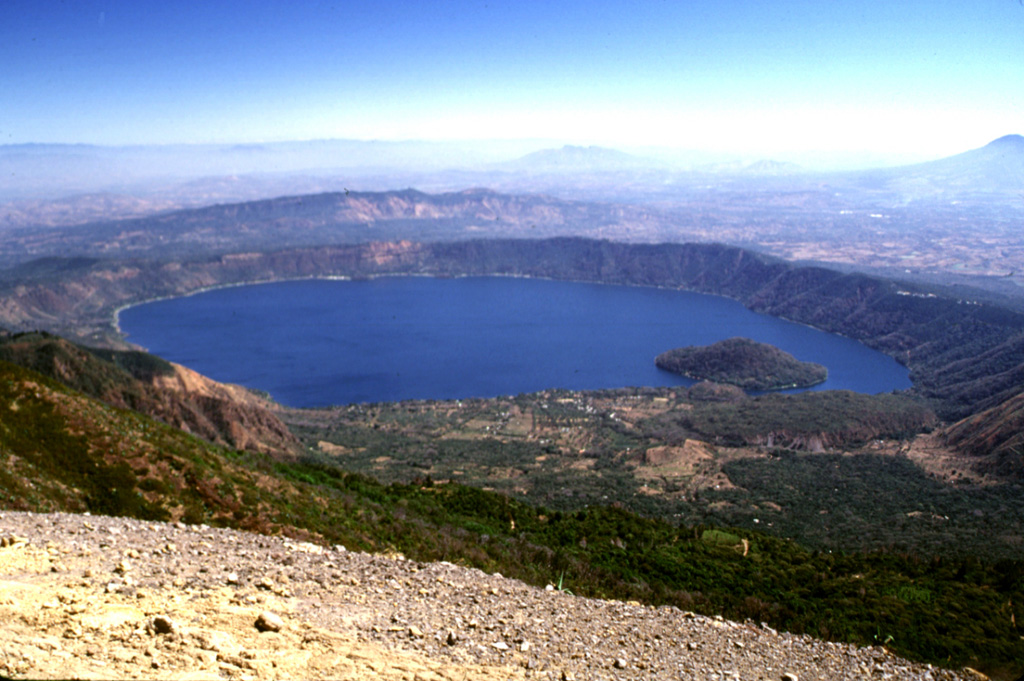
The Global Volcanism Program has no activity reports available for Coatepeque Caldera.
The Global Volcanism Program has no Weekly Reports available for Coatepeque Caldera.
The Global Volcanism Program has no Bulletin Reports available for Coatepeque Caldera.
|
|
||||||||||||||||||||||||||||
The Global Volcanism Program is not aware of any Holocene eruptions from Coatepeque Caldera. If this volcano has had large eruptions (VEI >= 4) prior to 12,000 years ago, information might be found on the Coatepeque Caldera page in the LaMEVE (Large Magnitude Explosive Volcanic Eruptions) database, a part of the Volcano Global Risk Identification and Analysis Project (VOGRIPA).
This compilation of synonyms and subsidiary features may not be comprehensive. Features are organized into four major categories: Cones, Craters, Domes, and Thermal Features. Synonyms of features appear indented below the primary name. In some cases additional feature type, elevation, or location details are provided.
Synonyms |
||||
| Ojo del Mar | ||||
Cones |
||||
| Feature Name | Feature Type | Elevation | Latitude | Longitude |
| Alto, Cerro | Pyroclastic cone | 953 m | 13° 48' 43.00" N | 89° 32' 49.00" W |
| Cañitas, Cerro | Pyroclastic cone | 1002 m | 13° 53' 38.00" N | 89° 31' 50.00" W |
| Ceiba Chacha, Cerro | Pyroclastic cone | 831 m | 13° 53' 0.00" N | 89° 33' 0.00" W |
| Guacamayero, Cerro | Pyroclastic cone | 910 m | 13° 50' 48.00" N | 89° 34' 58.00" W |
| Leona, Cerro la | Pyroclastic cone | 1100 m | 13° 54' 7.00" N | 89° 32' 6.00" W |
Domes |
||||
| Feature Name | Feature Type | Elevation | Latitude | Longitude |
| Afate, Cerro
Apale |
Dome | 809 m | 13° 50' 42.00" N | 89° 34' 5.00" W |
| Anteojos, Los | Dome | 771 m | 13° 52' 34.00" N | 89° 31' 30.00" W |
| Cuidad Arce, Cerrito | Dome | 13° 50' 0.00" N | 89° 27' 0.00" W | |
| Gloria, Cerro la | Dome | 13° 57' 0.00" N | 89° 31' 0.00" W | |
| Grande, Cerro
Isla del Cerro Cabra, Isla de |
Dome | 916 m | 13° 50' 35.00" N | 89° 33' 40.00" W |
| Pacho, Cerro | Dome | 947 m | 13° 50' 20.00" N | 89° 34' 41.00" W |
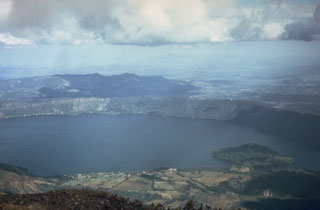 Coatepeque caldera iseast of Santa Ana volcano. The eastern caldera rim rises about 250 m above the lake surface in this 1972 photo. Post-caldera eruptions included the formation of basaltic scoria cones and flows near the western margin, and the extrusion of lava domes (such as Cerro Grande forming the island to the right) along a NE-SW line near the caldera lake margins.
Coatepeque caldera iseast of Santa Ana volcano. The eastern caldera rim rises about 250 m above the lake surface in this 1972 photo. Post-caldera eruptions included the formation of basaltic scoria cones and flows near the western margin, and the extrusion of lava domes (such as Cerro Grande forming the island to the right) along a NE-SW line near the caldera lake margins. 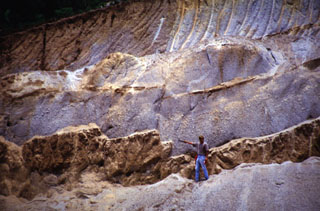 The thick light-colored unit the volcanologist is pointing to is the Arce fall deposit, overlying a paleosol and mafic ash and scoria deposits. This outcrop is about 15 km NW of the caldera rim. The biotite-rich rhyolitic Arce pumice-fall deposit was erupted from Coatepeque caldera about 72,000 years ago and was associated with formation of the SW part of the caldera. Deposits of the 84,000-year-old Los Chocoyos Ash from Atitlán caldera in Guatemala lie about 3 m below the base of the Arce deposit, but are not visible in this photo.
The thick light-colored unit the volcanologist is pointing to is the Arce fall deposit, overlying a paleosol and mafic ash and scoria deposits. This outcrop is about 15 km NW of the caldera rim. The biotite-rich rhyolitic Arce pumice-fall deposit was erupted from Coatepeque caldera about 72,000 years ago and was associated with formation of the SW part of the caldera. Deposits of the 84,000-year-old Los Chocoyos Ash from Atitlán caldera in Guatemala lie about 3 m below the base of the Arce deposit, but are not visible in this photo. 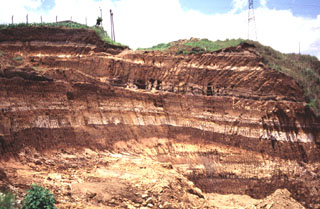 Light-colored rhyolite airfall pumice deposits from Coatepeque caldera are exposed in this quarry 20 km east of the caldera. These deposits were emplaced over much of SW El Salvador, and with the associated pyroclastic flow deposits have a volume of about 56 km3. The earlier biotite-bearing Arce deposits were produced during the largest eruption from Coatepeque about 72,000 years ago and are about 50 cmr thick at the Guatemalan border. The overlying Congo deposits originated during the second largest eruption of Coatepeque.
Light-colored rhyolite airfall pumice deposits from Coatepeque caldera are exposed in this quarry 20 km east of the caldera. These deposits were emplaced over much of SW El Salvador, and with the associated pyroclastic flow deposits have a volume of about 56 km3. The earlier biotite-bearing Arce deposits were produced during the largest eruption from Coatepeque about 72,000 years ago and are about 50 cmr thick at the Guatemalan border. The overlying Congo deposits originated during the second largest eruption of Coatepeque.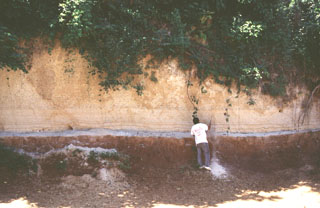 A volcanologist investigates an exposure of the Arce deposits on the eastern flank of Chilamatal caldera, about 10 km ENE of the rim of Coatepeque caldera. The Arce eruption around 72,000 years ago produced about 40 km3 of tephra and was associated with the first caldera-forming event at Coatepeque. The Arce deposits consist of two thick biotite-rich pumice fall deposits, separated by thin tephra deposits containing ash, pumice, and lithics. These ashfall deposits are distributed over much of western El Salvador.
A volcanologist investigates an exposure of the Arce deposits on the eastern flank of Chilamatal caldera, about 10 km ENE of the rim of Coatepeque caldera. The Arce eruption around 72,000 years ago produced about 40 km3 of tephra and was associated with the first caldera-forming event at Coatepeque. The Arce deposits consist of two thick biotite-rich pumice fall deposits, separated by thin tephra deposits containing ash, pumice, and lithics. These ashfall deposits are distributed over much of western El Salvador.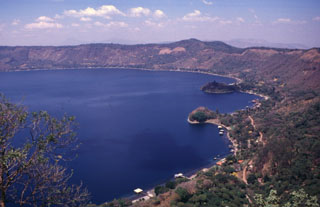 The Anteojos lava domes form peninsulas on the eastern shore of Lake Coatepeque, most of which lie beneath the lake surface. Four other domes formed in the opposite side of the caldera along a trend that passes through Izalco volcano to the SW. Two scoria cones on the horizon erupted along caldera ring faults.
The Anteojos lava domes form peninsulas on the eastern shore of Lake Coatepeque, most of which lie beneath the lake surface. Four other domes formed in the opposite side of the caldera along a trend that passes through Izalco volcano to the SW. Two scoria cones on the horizon erupted along caldera ring faults.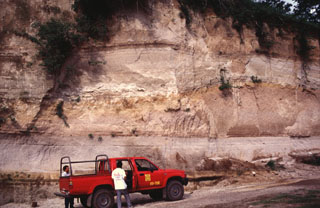 Rhyolite pumice fall and pyroclastic flow deposits from the two caldera-forming eruptions (Arce and Congo) at Coatepeque are exposed in this quarry wall. The lower Arce pumice and overlying pyroclastic flow deposit have a total volume about 40 km3 and were emplaced during the 72,000 BP eruption that formed the NE part of the caldera. The upper deposits (above the undulating brown paleosol in the center of the photo) are from the 16 km3 Congo eruption prior to about 57,000 years ago and were erupted through a caldera lake.
Rhyolite pumice fall and pyroclastic flow deposits from the two caldera-forming eruptions (Arce and Congo) at Coatepeque are exposed in this quarry wall. The lower Arce pumice and overlying pyroclastic flow deposit have a total volume about 40 km3 and were emplaced during the 72,000 BP eruption that formed the NE part of the caldera. The upper deposits (above the undulating brown paleosol in the center of the photo) are from the 16 km3 Congo eruption prior to about 57,000 years ago and were erupted through a caldera lake.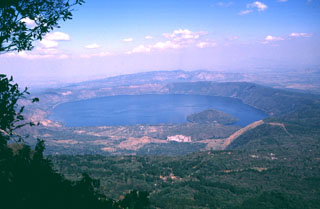 Coatepeque caldera is seen here from the summit of Cerro Verde to the SSW, a flank cone of Santa Ana volcano. Lago de Coatepeque fills the NE part of the 7 x 10 km caldera. The younger SW side of the caldera extends into Santa Ana volcano and to the sudden break in slope seen in the lower right of the photo. The caldera floor is higher on this side as a result of the accumulation of volcaniclastic debris from Santa Ana and the eruption of a series of post-caldera lava domes, one of which forms the island in the lake.
Coatepeque caldera is seen here from the summit of Cerro Verde to the SSW, a flank cone of Santa Ana volcano. Lago de Coatepeque fills the NE part of the 7 x 10 km caldera. The younger SW side of the caldera extends into Santa Ana volcano and to the sudden break in slope seen in the lower right of the photo. The caldera floor is higher on this side as a result of the accumulation of volcaniclastic debris from Santa Ana and the eruption of a series of post-caldera lava domes, one of which forms the island in the lake.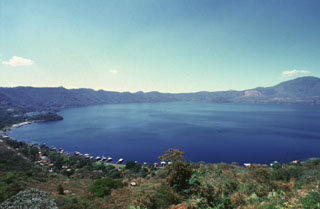 Lago de Coatepeque fills the 7 x 10 km Coatepeque caldera in western El Salvador. The caldera formed during two major eruptions in the late Pleistocene. Post-caldera eruptions produced a series of lava domes such as the one seen to the left that forms a small peninsula extending into the lake. A chain of scoria cones that erupted along caldera ring faults are across the southern caldera rim in the background.
Lago de Coatepeque fills the 7 x 10 km Coatepeque caldera in western El Salvador. The caldera formed during two major eruptions in the late Pleistocene. Post-caldera eruptions produced a series of lava domes such as the one seen to the left that forms a small peninsula extending into the lake. A chain of scoria cones that erupted along caldera ring faults are across the southern caldera rim in the background.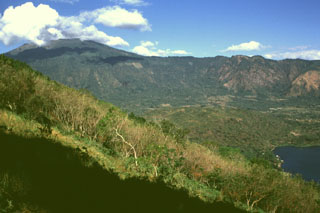 Santa Ana is seen here from the east on the rim of Coatepeque caldera. The eastern rim of Santa Ana's summit crater was breached and produced the gently sloping deposits extending towards the caldera lake to the lower right. The NW wall of the caldera in the background cuts into the flanks of Santa Ana. This SW part of Coatepeque caldera formed about 57,000 years ago during the eruption of about 16 km3 of rhyolite pumice and pyroclastic flow deposits.
Santa Ana is seen here from the east on the rim of Coatepeque caldera. The eastern rim of Santa Ana's summit crater was breached and produced the gently sloping deposits extending towards the caldera lake to the lower right. The NW wall of the caldera in the background cuts into the flanks of Santa Ana. This SW part of Coatepeque caldera formed about 57,000 years ago during the eruption of about 16 km3 of rhyolite pumice and pyroclastic flow deposits.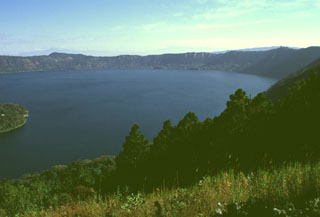 Lago de Coatepeque is within the eastern part of Coatepeque caldera, seen here from the southern caldera rim. The NE part of the caldera formed following the eruption of 40 km3 of rhyolitic pumice-fall and pyroclastic flow deposits about 72,000 years ago. The northern caldera rim in the distance rises about 250 m above the lake, which had a maximum depth of about 120 m when this photo was taken in 1999. Hot springs are located at several points along the shore of the lake near a group of post-caldera lava domes.
Lago de Coatepeque is within the eastern part of Coatepeque caldera, seen here from the southern caldera rim. The NE part of the caldera formed following the eruption of 40 km3 of rhyolitic pumice-fall and pyroclastic flow deposits about 72,000 years ago. The northern caldera rim in the distance rises about 250 m above the lake, which had a maximum depth of about 120 m when this photo was taken in 1999. Hot springs are located at several points along the shore of the lake near a group of post-caldera lava domes.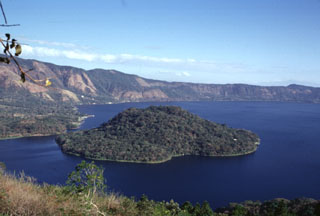 Cerro Grande is the largest of a series of post-caldera lava domes extruded along a NE-SW-trending line within Coatepeque caldera. The lava dome, seen here from the southern caldera rim, rises about 90 m above the lake surface and about 180 m above the lake floor.
Cerro Grande is the largest of a series of post-caldera lava domes extruded along a NE-SW-trending line within Coatepeque caldera. The lava dome, seen here from the southern caldera rim, rises about 90 m above the lake surface and about 180 m above the lake floor.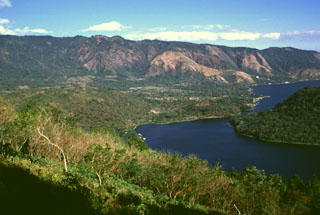 The SW part of Coatepeque caldera was formed about 57,000 years ago following the eruption of the roughly 16 km3 Congo biotite-bearing rhyolitic pumice fall and pyroclastic flow deposits. Plinian and phreatoplinian eruptions took place through a lake that formed in the NE part of the caldera that formed during the larger Arce eruption about 72,000 years ago.
The SW part of Coatepeque caldera was formed about 57,000 years ago following the eruption of the roughly 16 km3 Congo biotite-bearing rhyolitic pumice fall and pyroclastic flow deposits. Plinian and phreatoplinian eruptions took place through a lake that formed in the NE part of the caldera that formed during the larger Arce eruption about 72,000 years ago.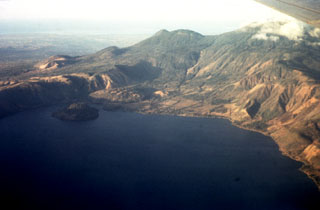 An aerial view of the western side of Coatepeque caldera shows Cerro Grande lava dome, the island to the left. On the ridge behind the caldera wall are (from left to right) the San Marcelino-Cerro la Olla and Cerro el Conejal-Cerro el Astillero complexes, the summit of Izalco volcano, rounded Cerro Verde scoria cone, and (in the clouds) the summit of Santa Ana volcano. The Pacific Ocean is visible in the distance.
An aerial view of the western side of Coatepeque caldera shows Cerro Grande lava dome, the island to the left. On the ridge behind the caldera wall are (from left to right) the San Marcelino-Cerro la Olla and Cerro el Conejal-Cerro el Astillero complexes, the summit of Izalco volcano, rounded Cerro Verde scoria cone, and (in the clouds) the summit of Santa Ana volcano. The Pacific Ocean is visible in the distance.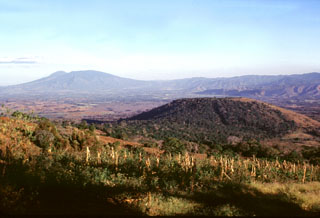 Cerro Alto (right) is a scoria cone on the SE flank of Coatepeque caldera, seen here from the southern caldera rim. Basaltic lava flows were erupted from the eastern side of the cone. Cerro Alto predates the formation of Coatepeque caldera and is overlain by deposits from the caldera-forming eruptions. San Salvador volcano is on the horizon to the east (left).
Cerro Alto (right) is a scoria cone on the SE flank of Coatepeque caldera, seen here from the southern caldera rim. Basaltic lava flows were erupted from the eastern side of the cone. Cerro Alto predates the formation of Coatepeque caldera and is overlain by deposits from the caldera-forming eruptions. San Salvador volcano is on the horizon to the east (left).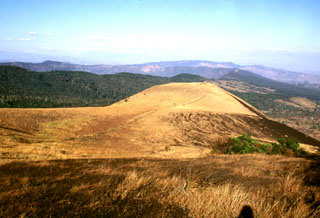 San Marcelino scoria cone is seen from Cerro Chino on the SE flank of Santa Ana. San Marcelino formed during an eruption in 1722 and produced a lava flow that traveled 13 km to the east. The vegetated southern rim of Coatepeque caldera can be seen to the NE (left) of San Marcelino.
San Marcelino scoria cone is seen from Cerro Chino on the SE flank of Santa Ana. San Marcelino formed during an eruption in 1722 and produced a lava flow that traveled 13 km to the east. The vegetated southern rim of Coatepeque caldera can be seen to the NE (left) of San Marcelino. The 7 x 10 km Coatepeque caldera is seen here from the Santa Ana summit. The caldera formed during a series of major explosive eruptions between about 70,000 and 57,000 years ago. Post-caldera eruptions included the formation of basaltic scoria cones and lava flows near the western margin of the caldera and the extrusion of lava domes, including Cerro Grande, the island in the W side of the caldera lake.
The 7 x 10 km Coatepeque caldera is seen here from the Santa Ana summit. The caldera formed during a series of major explosive eruptions between about 70,000 and 57,000 years ago. Post-caldera eruptions included the formation of basaltic scoria cones and lava flows near the western margin of the caldera and the extrusion of lava domes, including Cerro Grande, the island in the W side of the caldera lake.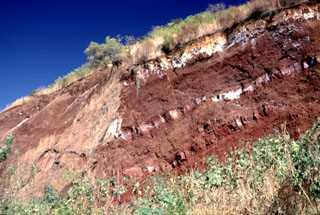 A quarry exposes red, oxidized scoria deposits with interbedded lighter lava flow units (possibly due to surface alteration) at Cerro la Leona scoria cone on the northern rim of Coatepeque caldera. The stratigraphy of the adjacent Cerro la Leona and Cerro Cañitas cones on the NE caldera rim were exposed by the caldera ring faults. At least ten other scoria cones on the eastern and southern caldera rims overlap ring faults.
A quarry exposes red, oxidized scoria deposits with interbedded lighter lava flow units (possibly due to surface alteration) at Cerro la Leona scoria cone on the northern rim of Coatepeque caldera. The stratigraphy of the adjacent Cerro la Leona and Cerro Cañitas cones on the NE caldera rim were exposed by the caldera ring faults. At least ten other scoria cones on the eastern and southern caldera rims overlap ring faults. 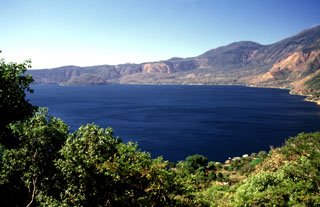 Lago de Coatepeque fills the eastern side of Coatepeque caldera. Post-caldera lava domes, including the rounded island of Cerro Grande at the far, left side of the lake, were erupted along a E-W-trending line. The rounded hill beyond the caldera and to the right is Cerro Verde.
Lago de Coatepeque fills the eastern side of Coatepeque caldera. Post-caldera lava domes, including the rounded island of Cerro Grande at the far, left side of the lake, were erupted along a E-W-trending line. The rounded hill beyond the caldera and to the right is Cerro Verde.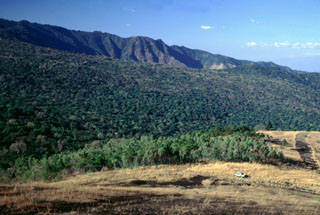 This view shows the western side of Coatepeque caldera (top of the photo) from Cerro Chino scoria cone on the SE flank of Santa Ana, which lies out of view to the left. The caldera rim partially cuts into the eastern side of Santa Ana. The western side of Coatepeque caldera is considered to have formed during the second stage of caldera formation through a lake partially filling the earlier caldera, producing the Congo Formation tephras and pyroclastic flows.
This view shows the western side of Coatepeque caldera (top of the photo) from Cerro Chino scoria cone on the SE flank of Santa Ana, which lies out of view to the left. The caldera rim partially cuts into the eastern side of Santa Ana. The western side of Coatepeque caldera is considered to have formed during the second stage of caldera formation through a lake partially filling the earlier caldera, producing the Congo Formation tephras and pyroclastic flows.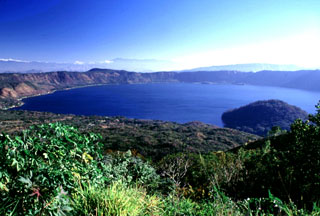 This view from the road to the Cerro Verde summit shows the eastern side of Coatepeque caldera. The hill in the lake (right) is the Cerro Grande lava dome. The caldera formed during two major explosive eruptions, the first of which occurred about 72,000 years ago, forming the eastern part of the caldera in association with the Arce pumice fall and pyroclastic flow deposits. A lake partially filled the caldera floor prior to the Congo eruption associated with formation of the western part of the caldera.
This view from the road to the Cerro Verde summit shows the eastern side of Coatepeque caldera. The hill in the lake (right) is the Cerro Grande lava dome. The caldera formed during two major explosive eruptions, the first of which occurred about 72,000 years ago, forming the eastern part of the caldera in association with the Arce pumice fall and pyroclastic flow deposits. A lake partially filled the caldera floor prior to the Congo eruption associated with formation of the western part of the caldera.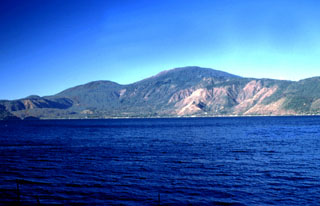 Santa Ana volcano rises above Lago de Coatepeque. The 6-km-wide lake lies at the eastern end of the Coatepeque caldera. The northern and southern rims of the western side of the caldera are visible beyond the lake. The rounded peak to the left of Santa Ana is Cerro Verde, one of many cones along a NW-SE-trending fissure cutting across the Santa Ana complex.
Santa Ana volcano rises above Lago de Coatepeque. The 6-km-wide lake lies at the eastern end of the Coatepeque caldera. The northern and southern rims of the western side of the caldera are visible beyond the lake. The rounded peak to the left of Santa Ana is Cerro Verde, one of many cones along a NW-SE-trending fissure cutting across the Santa Ana complex.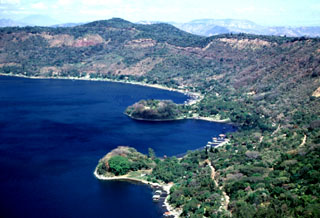 The Los Anteojos lava domes form small peninsulas on the eastern shore of Lago de Coatepeque. Four other domes are on the opposite side of the caldera in a trend that passes through Izalco volcano to the SW. The Anteojos domes are mostly submerged, rising only about 20-25 m above the lake surface in this 2002 photo. A chain of scoria cones was erupted along caldera ring faults; two of these are seen beyond the two domes.
The Los Anteojos lava domes form small peninsulas on the eastern shore of Lago de Coatepeque. Four other domes are on the opposite side of the caldera in a trend that passes through Izalco volcano to the SW. The Anteojos domes are mostly submerged, rising only about 20-25 m above the lake surface in this 2002 photo. A chain of scoria cones was erupted along caldera ring faults; two of these are seen beyond the two domes.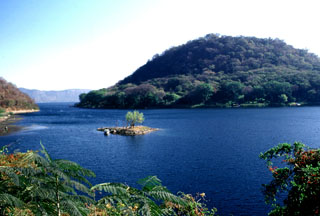 This vegetated island is Cerro Grande, a post-caldera lava dome in the SW side of Coatepeque caldera. The partially submerged dome has a basal diameter of about 2.5 km and a volume of about 0.5 km3. The smaller San Pedro Island with one tree is exposed during low lake levels.
This vegetated island is Cerro Grande, a post-caldera lava dome in the SW side of Coatepeque caldera. The partially submerged dome has a basal diameter of about 2.5 km and a volume of about 0.5 km3. The smaller San Pedro Island with one tree is exposed during low lake levels.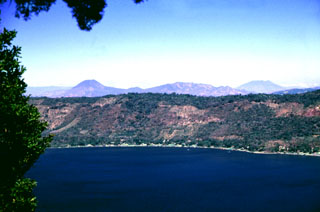 The northern wall of Coatepeque caldera rises about 250 m above the surface of Lago de Coatepeque, whose shores are lined with residences and small hotels. The peak beyond the caldera to the left is Volcán Chingo along the El Salvador/Guatemala border. The broader peak to the far right is Volcán Suchitán, one of the largest volcanoes in SE Guatemala.
The northern wall of Coatepeque caldera rises about 250 m above the surface of Lago de Coatepeque, whose shores are lined with residences and small hotels. The peak beyond the caldera to the left is Volcán Chingo along the El Salvador/Guatemala border. The broader peak to the far right is Volcán Suchitán, one of the largest volcanoes in SE Guatemala. 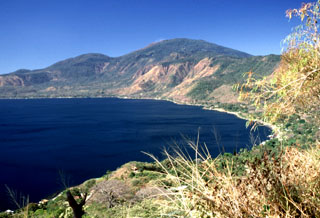 Coatepeque caldera is seen here from its northern rim, with Santa Ana volcano in the background. The caldera walls rise from 250 m to about 1 km above the lake and the stratigraphy is exposed in some areas. The rounded summit behind the caldera rim to the left is Cerro Verde, which was erupted along a NW-SE-trending fissure cutting through Santa Ana.
Coatepeque caldera is seen here from its northern rim, with Santa Ana volcano in the background. The caldera walls rise from 250 m to about 1 km above the lake and the stratigraphy is exposed in some areas. The rounded summit behind the caldera rim to the left is Cerro Verde, which was erupted along a NW-SE-trending fissure cutting through Santa Ana. 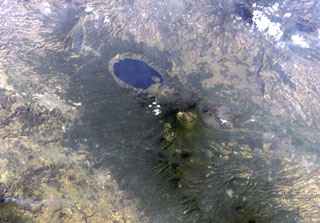 Lake-filled Coatepeque caldera is prominent in this International Space Station image with north to the lower left. A post-caldera lava dome forms an island at the SW side of the lake. The nested summit craters of Santa Ana volcano are visible below and to the right of Coatepeque, and the unvegetated cone of Izalco volcano is to the right of Santa Ana. Small stratovolcanoes of the Sierra de Apaneca form the forested ridge at the bottom right. The light-colored area at the left-center is the city of Santa Ana, the second largest in El Salvador.
Lake-filled Coatepeque caldera is prominent in this International Space Station image with north to the lower left. A post-caldera lava dome forms an island at the SW side of the lake. The nested summit craters of Santa Ana volcano are visible below and to the right of Coatepeque, and the unvegetated cone of Izalco volcano is to the right of Santa Ana. Small stratovolcanoes of the Sierra de Apaneca form the forested ridge at the bottom right. The light-colored area at the left-center is the city of Santa Ana, the second largest in El Salvador.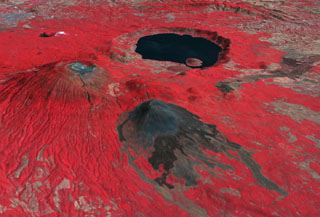 This false-color oblique DEM overlain by a thermal infrared ASTER image shows Santa Ana volcano (middle left), Izalco volcano (center), and the roughly 5.5 x 6 km Coatepeque caldera lake from the SW. The summit of Santa Ana has series of nested craters, and a NW-SE-trending fissure across the edifice. Lava flows were recently emplaced across the southern flanks of Izalco. The grayish area at the far upper left is the city of Santa Ana, El Salvador.
This false-color oblique DEM overlain by a thermal infrared ASTER image shows Santa Ana volcano (middle left), Izalco volcano (center), and the roughly 5.5 x 6 km Coatepeque caldera lake from the SW. The summit of Santa Ana has series of nested craters, and a NW-SE-trending fissure across the edifice. Lava flows were recently emplaced across the southern flanks of Izalco. The grayish area at the far upper left is the city of Santa Ana, El Salvador.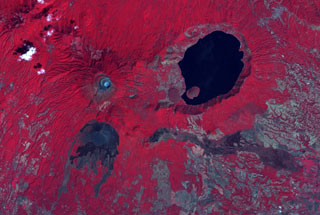 The summit crater complex of Santa Ana volcano with its small light-bluish crater lake is visible at the left-center in this false-color ASTER satellite image (N is to the top; this image is approximately 30 km across). The lake-filled Coatepeque caldera is east of Santa Ana, and Izalco volcano with its lava flows are to the south. A fissure was the source of an eruption in 1722 CE from a scoria cone (center) on the SE flank that produced the lava flow across the image to the lower right.
The summit crater complex of Santa Ana volcano with its small light-bluish crater lake is visible at the left-center in this false-color ASTER satellite image (N is to the top; this image is approximately 30 km across). The lake-filled Coatepeque caldera is east of Santa Ana, and Izalco volcano with its lava flows are to the south. A fissure was the source of an eruption in 1722 CE from a scoria cone (center) on the SE flank that produced the lava flow across the image to the lower right.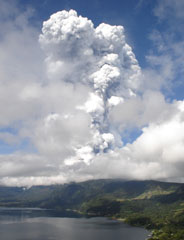 An ash-and-steam plume from Santa Ana towers above Coatepeque caldera lake. The one-hour explosive eruption the morning of 1 October 2005 produced plumes that rose 10 km or more. Ash fell in towns west of the volcano and extended into Guatemala. Volcanic blocks up to a meter in diameter fell as far as 2 km south of the summit. Lahars descended valleys on the flanks of the volcano.
An ash-and-steam plume from Santa Ana towers above Coatepeque caldera lake. The one-hour explosive eruption the morning of 1 October 2005 produced plumes that rose 10 km or more. Ash fell in towns west of the volcano and extended into Guatemala. Volcanic blocks up to a meter in diameter fell as far as 2 km south of the summit. Lahars descended valleys on the flanks of the volcano.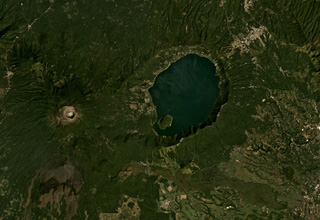 The 7 x 10 km lake-filled Coatepeque Caldera formed 72 ka and is shown in this November 2019 Planet Labs satellite image monthly mosaic (N is at the top; this image is approximately 25 km across). The western caldera rim formed on the Santa Maria eastern flank, and several lava domes formed in the SW area with Cerro Grande forming the island within the lake. Santa Ana with its blue-green crater lake and Izalco with the unvegetated slopes are W and SW, respectively.
The 7 x 10 km lake-filled Coatepeque Caldera formed 72 ka and is shown in this November 2019 Planet Labs satellite image monthly mosaic (N is at the top; this image is approximately 25 km across). The western caldera rim formed on the Santa Maria eastern flank, and several lava domes formed in the SW area with Cerro Grande forming the island within the lake. Santa Ana with its blue-green crater lake and Izalco with the unvegetated slopes are W and SW, respectively.There are no samples for Coatepeque Caldera in the Smithsonian's NMNH Department of Mineral Sciences Rock and Ore collection.
| Copernicus Browser | The Copernicus Browser replaced the Sentinel Hub Playground browser in 2023, to provide access to Earth observation archives from the Copernicus Data Space Ecosystem, the main distribution platform for data from the EU Copernicus missions. |
| MIROVA | Middle InfraRed Observation of Volcanic Activity (MIROVA) is a near real time volcanic hot-spot detection system based on the analysis of MODIS (Moderate Resolution Imaging Spectroradiometer) data. In particular, MIROVA uses the Middle InfraRed Radiation (MIR), measured over target volcanoes, in order to detect, locate and measure the heat radiation sourced from volcanic activity. |
| MODVOLC Thermal Alerts | Using infrared satellite Moderate Resolution Imaging Spectroradiometer (MODIS) data, scientists at the Hawai'i Institute of Geophysics and Planetology, University of Hawai'i, developed an automated system called MODVOLC to map thermal hot-spots in near real time. For each MODIS image, the algorithm automatically scans each 1 km pixel within it to check for high-temperature hot-spots. When one is found the date, time, location, and intensity are recorded. MODIS looks at every square km of the Earth every 48 hours, once during the day and once during the night, and the presence of two MODIS sensors in space allows at least four hot-spot observations every two days. Each day updated global maps are compiled to display the locations of all hot spots detected in the previous 24 hours. There is a drop-down list with volcano names which allow users to 'zoom-in' and examine the distribution of hot-spots at a variety of spatial scales. |
|
WOVOdat
Single Volcano View Temporal Evolution of Unrest Side by Side Volcanoes |
WOVOdat is a database of volcanic unrest; instrumentally and visually recorded changes in seismicity, ground deformation, gas emission, and other parameters from their normal baselines. It is sponsored by the World Organization of Volcano Observatories (WOVO) and presently hosted at the Earth Observatory of Singapore.
GVMID Data on Volcano Monitoring Infrastructure The Global Volcano Monitoring Infrastructure Database GVMID, is aimed at documenting and improving capabilities of volcano monitoring from the ground and space. GVMID should provide a snapshot and baseline view of the techniques and instrumentation that are in place at various volcanoes, which can be use by volcano observatories as reference to setup new monitoring system or improving networks at a specific volcano. These data will allow identification of what monitoring gaps exist, which can be then targeted by remote sensing infrastructure and future instrument deployments. |
| Volcanic Hazard Maps | The IAVCEI Commission on Volcanic Hazards and Risk has a Volcanic Hazard Maps database designed to serve as a resource for hazard mappers (or other interested parties) to explore how common issues in hazard map development have been addressed at different volcanoes, in different countries, for different hazards, and for different intended audiences. In addition to the comprehensive, searchable Volcanic Hazard Maps Database, this website contains information about diversity of volcanic hazard maps, illustrated using examples from the database. This site is for educational purposes related to volcanic hazard maps. Hazard maps found on this website should not be used for emergency purposes. For the most recent, official hazard map for a particular volcano, please seek out the proper institutional authorities on the matter. |
| IRIS seismic stations/networks | Incorporated Research Institutions for Seismology (IRIS) Data Services map showing the location of seismic stations from all available networks (permanent or temporary) within a radius of 0.18° (about 20 km at mid-latitudes) from the given location of Coatepeque Caldera. Users can customize a variety of filters and options in the left panel. Note that if there are no stations are known the map will default to show the entire world with a "No data matched request" error notice. |
| UNAVCO GPS/GNSS stations | Geodetic Data Services map from UNAVCO showing the location of GPS/GNSS stations from all available networks (permanent or temporary) within a radius of 20 km from the given location of Coatepeque Caldera. Users can customize the data search based on station or network names, location, and time window. Requires Adobe Flash Player. |
| DECADE Data | The DECADE portal, still in the developmental stage, serves as an example of the proposed interoperability between The Smithsonian Institution's Global Volcanism Program, the Mapping Gas Emissions (MaGa) Database, and the EarthChem Geochemical Portal. The Deep Earth Carbon Degassing (DECADE) initiative seeks to use new and established technologies to determine accurate global fluxes of volcanic CO2 to the atmosphere, but installing CO2 monitoring networks on 20 of the world's 150 most actively degassing volcanoes. The group uses related laboratory-based studies (direct gas sampling and analysis, melt inclusions) to provide new data for direct degassing of deep earth carbon to the atmosphere. |
| Large Eruptions of Coatepeque Caldera | Information about large Quaternary eruptions (VEI >= 4) is cataloged in the Large Magnitude Explosive Volcanic Eruptions (LaMEVE) database of the Volcano Global Risk Identification and Analysis Project (VOGRIPA). |
| EarthChem | EarthChem develops and maintains databases, software, and services that support the preservation, discovery, access and analysis of geochemical data, and facilitate their integration with the broad array of other available earth science parameters. EarthChem is operated by a joint team of disciplinary scientists, data scientists, data managers and information technology developers who are part of the NSF-funded data facility Integrated Earth Data Applications (IEDA). IEDA is a collaborative effort of EarthChem and the Marine Geoscience Data System (MGDS). |